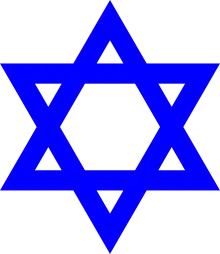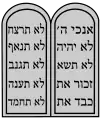Seudah shlishit
Seudah shlishit (Hebrew: סעודה שלישית 'third meal') or shaleshudes (Ashkenazic and Yiddish: שלוש־סעודות) is the third meal customarily eaten by Sabbath-observing Jews on each Shabbat (observed on Saturdays) and in the Arba'ah Turim each Yom Tov. It is also known as shalosh seudos ("three meals") in reference to an aggadic passage from the Talmud.
| Part of a series on |
| Judaism |
|---|
   |
|
The Biblical basis is Ex. 16:25, in which the word for day, HaYom, appears three times with reference to the Manna that fell in a double portion on Friday.
Practices
According to Halakha, the meal is to be eaten in the afternoon.[1] It is usually the smallest of the three meals, often consisting of foods such as salads and gefilte fish in Ashkenazi custom and tuna, harissa, and fruits in Mizrachi and Sephardi customs.
It has special significance because it is a mitzvah ("commandment") to eat three meals on the Sabbath. In Hasidic communities, this mitzvah is carried out with great enthusiasm as the Hitveadut. In some Hasidic circles, this third meal continues hours after the Sabbath has officially ended concluding with Birkat HaMazon over the same cup with Havdalah giving rise to the tradition of Melaveh Malkah. The lights might be turned off, either by a timer, or by a person after the Sabbath has ended. Some have a custom to rise and "accept the Kingdom of Heaven", by reciting "A-donai melech, A-donai malach, A-donai yimloch l'olam va'ed!" (The Lord is King, the Lord was King, the Lord will always be King) and "Hear Israel, the Lord is our God, the Lord is One" (Sh'ma Yisrael, A-donai E-loheinu, A-donai Echad).
While most poskim (Jewish legal decisors) encourage people to eat bread at this meal, most agree that eating cake or fruit will minimally suffice. However, many Jews of the Hasidic Chabad-Lubavitch community have a custom specifically to refrain from eating bread at this meal, as do some German Jews.
Special Sabbath songs that are often sung at this meal include Bnei Heichala (a Kabbalistic hymn by Rabbi Isaac Luria), Mizmor L'David (23rd Psalm), and Yedid Nefesh (a piyyut, or liturgical poem, composed by 16th century Kabbalist Rabbi Eliezer Azikri).[2] Some also finish the morning hymn Baruch Adonai Yom Yom, starting either from the words B'vo'o M'Edom or Y'tzaveh Tzur Chasdo. Many recite the "Acceptance of the Kingdom of Heaven" before the last verse of this hymn. Some sing other Sabbath morning hymns, and some Kabbalistic hymns for the third meal, such as Kel Mistater. During the meals from Passover until Rosh Hashanah, many recite Pirkei Avot during the meal, one or two chapters per week, so as to finish three times.
Although according to some opinions one is required to recite kiddush at this meal, most say it is not necessary. However, some have either maintained the recitation of kiddush as a custom, or merely partake of some wine or grape juice in order to recite the blessing, but do not consider it as the recitation of kiddush. Others have no particular custom as to the partaking of wine or grape juice at this meal.
Shabbat meals
The Talmud (tractate Shabbat 117b) states that a Jew must eat three meals on the Sabbath day, based on a derivation from a Biblical passage referring to Shabbat. Some rabbinic commentators conjecture that this three meal requirement was instituted in order to lend a special measure of honor to Shabbat, since the normative practice at the time was to eat two meals in the course of a normal weekday: one during the day and one at night.
Later rabbinic sources list great spiritual rewards for eating this third meal and state that it is equivalent to all the meals combined. Indeed, while sometimes called seudah shlishit, or "third meal," it is often called shalosh seudos, "three meals" for its significance.
While not described as a required act, it has become common practice today. In commemoration of the double portion of manna that fell for Shabbat, it is customary to have two loaves of bread at each meal. Among European Jewry this bread often takes the form of the traditional braided challah, while Middle Eastern Jews normally use pita. Some Ashkenazic Jews also use matzah for this meal.
See also
External links
Notes
- "Seuda Shlishit – Shalosh S'Udot", Union of Orthodox Jewish Congregations of America, accessed March 16, 2006.
- Rebbetzin Lori Palatnik, "Shabbat Afternoon and Third Meal", Aish HaTorah, accessed March 16, 2006.